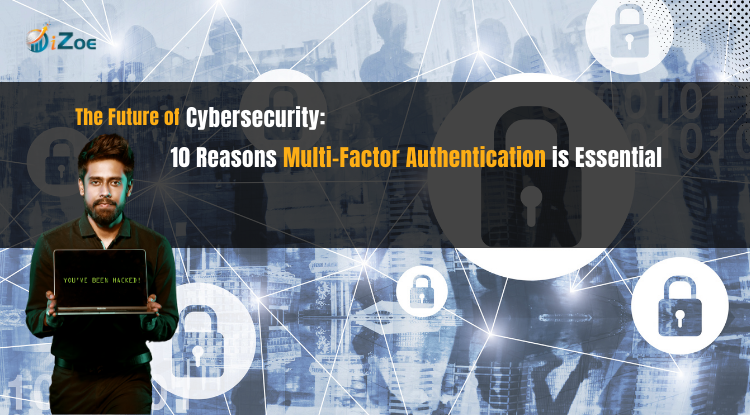Did you know that over 80% of data breaches are caused by compromised passwords?
Traditional authentication methods, such as username-password combinations, are highly vulnerable to cyberattacks like phishing, keylogging, and brute-force attacks. This is why leading platforms like Google, Amazon, and Netflix have adopted Multi-Factor Authentication (MFA) to strengthen security.
What Is Multi-Factor Authentication (MFA)?
MFA is a security system that requires users to verify their identity through two or more authentication factors before gaining access to an account or system. Unlike passwords alone, MFA adds extra layers of security, making it significantly harder for hackers to gain unauthorized access.
Types of Authentication Factors:
- A password or PIN.
- A smartphone, hardware token, or security key.
- Biometric verification such as fingerprint or facial recognition.
Common MFA Methods:
1. One-Time Passwords (OTP):
Codes sent via SMS or email (prone to interception).
2. Authenticator Apps (TOTP):
Generates time-sensitive codes on the user’s device.
3. Hardware Tokens:
Physical devices that generate secure access codes.
4. Biometric Authentication:
Uses fingerprints, face scans, or voice recognition.
5. Push Notifications:
Approve or deny login attempts via a trusted device.
Real-World Use Cases of Multi-Factor Authentication
MFA is widely used to enhance security in various sectors. For example, companies integrate MFA with Single Sign-On (SSO) to protect sensitive corporate data. Before accessing critical systems, employees must verify their identity with an extra step, like an SMS code or biometric scan.
Similarly, banks implement MFA for online banking, ensuring customers confirm transactions using an additional factor such as a one-time code or fingerprint authentication. These measures significantly reduce the risk of unauthorized access and financial fraud.
10 Benefits of Multi-Factor Authentication
- Enhanced Security
MFA creates multiple barriers against cyberattacks, reducing the likelihood of unauthorized access even if a password is compromised.
- Protection Against Phishing Attacks
Even if a hacker steals your password, MFA ensures they cannot access your account without the additional verification factor.
- Reduced Risk of Credential Theft
Since passwords alone are not enough, MFA drastically reduces the impact of stolen or leaked credentials.
- Customizable Security Policies
Organizations can set different authentication levels based on user roles, location, and risk levels, balancing security and user experience.
- Increased User Trust
Users feel more secure knowing that their accounts are protected by more than just a password, enhancing confidence in businesses and service providers.
- Seamless Integration with Existing Systems
Modern MFA solutions integrate smoothly with existing security infrastructure, including Single Sign-On (SSO) and cloud-based applications.
- Cost-Effective Security
Preventing data breaches is significantly cheaper than dealing with their consequences. Implementing MFA can save businesses from costly cyberattacks and legal fines.
- Future-Proof Security
MFA solutions are adaptable and can incorporate emerging security technologies, such as biometric advancements and AI-driven authentication.
- Prevention of Password Fatigue
Users no longer have to create and remember complex passwords for every account, reducing frustration while enhancing security.
- Improved Access Management
MFA allows organizations to monitor access attempts and enforce stronger security policies for high-risk activities.
Why Traditional Security Mechanisms Are Failing
1. Single Point of Failure:
The entire account is at risk if a password is compromised.
2. Password Reuse:
Many users reuse passwords, making multiple accounts vulnerable if one is breached.
3. Phishing Vulnerability:
Users often fall victim to phishing attacks that steal login credentials.
MFA mitigates these risks by requiring an extra step beyond passwords, significantly improving security.
Balancing Security and User Experience
While MFA improves security, poorly implemented authentication can frustrate users. To enhance usability, organizations should:
- Offer multiple MFA options (e.g., SMS, authenticator apps, biometrics).
- Use risk-based authentication to trigger MFA only when necessary.
- Implement Single Sign-On (SSO) to streamline authentication.
The Future of MFA
As biometric technology becomes more affordable, its adoption in MFA solutions will continue to grow, making authentication more secure and convenient. Additionally, AI-driven adaptive authentication will analyze user behavior and adjust security measures dynamically, reducing friction while enhancing protection.
These advancements will make MFA more efficient, seamless, and widely accessible in the coming years.
Conclusion
With cyber threats on the rise, relying on passwords alone is no longer an option. MFA strengthens security by requiring multiple verification factors, making it exponentially harder for attackers to compromise accounts. Businesses must implement MFA to protect sensitive data, ensure compliance, and build user trust.
How iZoe Can Help
At Izoe, we specialize in cutting-edge cybersecurity solutions, including MFA implementation and integration, risk assessment, and secure access management. Our team helps businesses strengthen their security posture and protect sensitive data from cyber threats.
Contact iZoe today for expert cybersecurity services tailored to your needs!

